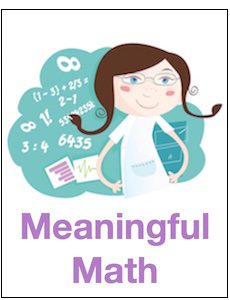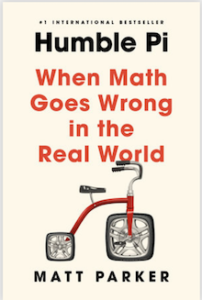When Math Goes Wrong in the Real World
A MiddleWeb Blog

The front cover actually describes it as a book for the people (millions of them?) who asked that question in math class.
Humble Pi is all about what happens when people don’t use what they learn in math class in the real world! A short synopsis explains that the book is “an entertaining tour of real-world mathematical disasters and what they reveal about the importance of math in our everyday lives.” Wow, that got my attention!
The book is very readable and the author is quite funny. I had never heard of him before but discovered he is a comedian (and former math teacher) and performs math stand-up routines. I did not even know that type of comedian existed!
How Is It Laid Out?
I really enjoyed the layout of the book. Every chapter is fairly short. I don’t think it’s the kind of book that you want to sit down and read all at one time. I put the book by my bed and read a chapter every night, and it was very enjoyable!
The chapters are broken up into different categories of math errors. For instance the first chapter deals with the time-keeping errors that come up when dealing with computers (remember Y2K?). The next chapter involves engineering mistakes related to bridges and resonance. There is also a chapter on shapes and statistics. Basically, almost any math subject or topic you teach will have a chapter that will apply.
Favorite Parts
Although there is humor throughout the book, Parker’s stories and examples can be quite serious at times. In the chapter “Out of Shape” there is an interesting section dealing with the Challenger tragedy which offers an in-depth discussion regarding the role the o-rings played in the disaster. Another chapter I really enjoyed was “You Can’t Count on It” which details the mistakes people make when counting.
By the way, the counting chapter sparked an intense debate in my family about how to count time. If you want to count four hours from now, do you start counting on the hour you are on or the next one? I found out that everyone does not do it the way I do, and I have to accept that. In any case this is a great chapter; I learned about fence post problems and OBOE (off by one error) computer programming errors.
My favorite chapter is “Probably Wrong.” It’s all about probability. Since I teach AP Statistics, I found a lot of useful tidbits to share with my class. There is a section dealing with height and basketball players that does a great job of explaining independent events.
My favorite sentence in the whole chapter deals with probability: “Probability is an area of math where not only does our intuition fail us, but it is also generally wrong.” So true! I plan to share that with my classes to let them know that it’s okay if it takes them awhile to catch on to probability.
Honestly, I enjoyed something from every chapter. Even with the ones I would start and think, this one doesn’t really interest me, by the end I was hooked! I actually got excited by some of the math tidbits I learned. Often I would go looking for some unsuspecting family member to talk with about parts of the book, and even though I’m the only self-proclaimed “math person,” they also enjoyed what I shared.
How Would I Use It the Classroom?
I think it would be fun to read excerpts from the book to jumpstart a discussion with my students. I absolutely think there are sections that some of my students would be interested in. I definitely plan to put it in my classroom library – among the selection of books that I allow my students to “check out” and take home if they choose. (There are also lots of Matt’s “maths” videos on YouTube. I’ll probably explain to my students that math = maths in Britain and Australia – where Matt is from.)
There are many examples in the book that illustrate how math is important in the real world, and that is something my students definitely need to hear. Also, over and over again this book illustrates the need for paying attention to detail and really thinking about what you doing, something that math teachers constantly remind their students.
If you are a math teacher, I promise you will find something to like in this book. If you are not a math teacher but have a passing interest in math, you will like it too! I can’t wait to see my students again face to face so I can share it with them!
On 4/24/20 Matt Parker shared a December video clip in which a young audience discovers what 80% accuracy looks like in real life.




































From my Navy days, I would say your signal is: BRAVO ZULU ( i.e. WELL DONE!!)
Your insights are ‘spot on’.
“An education in checkers will NOT prepare one for 3D chess”
Real world Numeracy demands understanding that the real world is fuzzy NOT binary — and math is a toolset.
Using the WRONG tool seldom does the job.